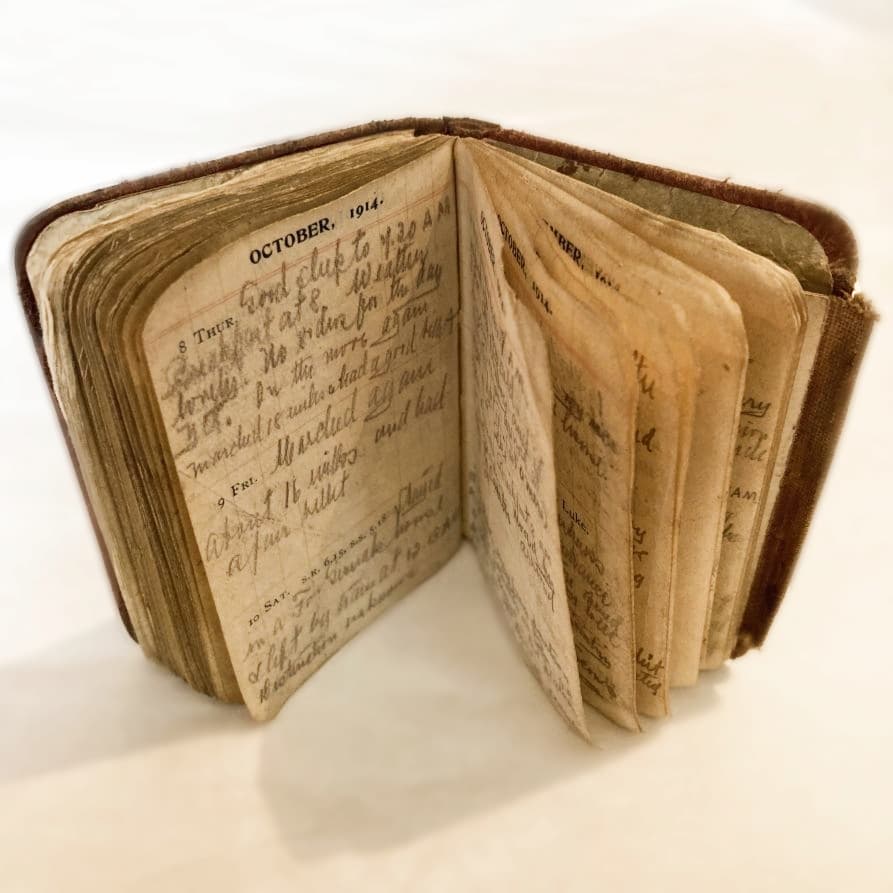SEAFORTH AND CAMERONS IN WWI
(1914 – 1918)
SEAFORTH AND CAMERONS IN WWI
(1914 – 1918)
THE REGIMENTS IN WWI…
THE REGIMENTS IN WWI…
Between the Seaforth, Camerons, Lovat Scouts, and Liverpool Scottish, there were over forty battalions across the Regular Army, Territorial Force, and New Army that were ready to fight at the start of WWI. This page will only cover the Regular Army, encompassing the 1st and 2nd Seaforths and Camerons; access more information about the other battalions here: Seaforth or Camerons
At the outbreak of the War, the 1st Seaforths were stationed in Agra, India; alongside battalions of the Indian Corps, they arrived in France in October 1914. A year later, the battalion moved to Mesopotamia (Iraq), and from January 1918, fought in Egypt and Palestine until the end of the War. The 2nd Seaforth had a very different experience – arriving in France on 23rd August 1914 as part of the British Expeditionary Force, they fought through some of the most well-known and exceptionally bloody battles on the Western Front.
The 1st Camerons left for France on 12th August 1914 and fought on the front line for the duration of the War. Having been stationed in India, the 2nd Camerons arrived in December 1914; having fought at the Battle of Ypres, they moved out to Eastern Europe and fought in Bulgaria, Macedonia, Greece, and Georgia.
Between the Seaforth, Camerons, Lovat Scouts, and Liverpool Scottish, there were over forty battalions across the Regular Army, Territorial Force, and New Army that were ready to fight at the start of WWI. This page will only cover the Regular Army, encompassing the 1st and 2nd Seaforths and Camerons; access more information about the other battalions here: Seaforth or Camerons
At the outbreak of the War, the 1st Seaforths were stationed in Agra, India; alongside battalions of the Indian Corps, they arrived in France in October 1914. A year later, the battalion moved to Mesopotamia (Iraq), and from January 1918, fought in Egypt and Palestine until the end of the War. The 2nd Seaforth had a very different experience – arriving in France on 23rd August 1914 as part of the British Expeditionary Force, they fought through some of the most well-known and exceptionally bloody battles on the Western Front.
The 1st Camerons left for France on 12th August 1914 and fought on the front line for the duration of the War. Having been stationed in India, the 2nd Camerons arrived in December 1914; having fought at the Battle of Ypres, they moved out to Eastern Europe and fought in Bulgaria, Macedonia, Greece, and Georgia.
KEY BATTLES…
KEY BATTLES…
1ST SEAFORTH BATTLES
Battle of La Bassee; France, 1914
Battle of Armentieres; France, 1914
The First Battle of Messines; Belgium, 1914
The Siege of Kut; 1914-1915, Iraq
Battle of Loos; France, 1915
Battle of Dujaila; Iraq, 1915
Battles of Sheikh Sa’ad, Wadi, and Umm-el-Hanna; Iraq, 1916
The Capture of Baghdad; Iraq, 1917
Battle of Beit Lid; Palestine, 1918
The Battle of Megidd; Palestine, 1918
2ND SEAFORTH BATTLES
Battle of Le Cateau; France, 1914
First Battle of the Marne; France, 1914
First Battle of the Aisne; France, 1914
Second Battle of Ypres; France, 1915
Battle of the Somme; France, 1916
First Battle of Passchendaele; Belgium, 1917
Battle of Messines; Belgium, 1917
1ST CAMERON BATTLES
Battle of Mons; France, 1914
Battle of the Marne; France, 1914
Battle of the Aisne; France, 1914
First Battle of Ypres; France, 1914
Battle of Aubers; France, 1915
Battle of Loos; France, 1915
Battle of the Somme; France, 1916
Second Battle of Passchendaele; Belgium, 1917
Battle of the Lys; France, 1918
2ND CAMERON BATTLES
Second Battle of Ypres; France, 1915
Capture of Karajakois and Yenikoi; Greece, 1916
Battle of Tumbitza Farm; Macedonia, 1916
Capture of Homondos; Greece, 1917
Capture of the Roche Noir Salient; Macedonia, 1918
1ST SEAFORTH BATTLES
Battle of La Bassee; France, 1914
Battle of Armentieres; France, 1914
The First Battle of Messines; Belgium, 1914
The Siege of Kut; 1914-1915, Iraq
Battle of Loos; France, 1915
Battle of Dujaila; Iraq, 1915
Battles of Sheikh Sa’ad, Wadi, and Umm-el-Hanna; Iraq, 1916
The Capture of Baghdad; Iraq, 1917
Battle of Beit Lid; Palestine, 1918
The Battle of Megidd; Palestine, 1918
2ND SEAFORTH BATTLES
Battle of Le Cateau; France, 1914
First Battle of the Marne; France, 1914
First Battle of the Aisne; France, 1914
Second Battle of Ypres; France, 1915
Battle of the Somme; France, 1916
First Battle of Passchendaele; Belgium, 1917
Battle of Messines; Belgium, 1917
1ST CAMERON BATTLES
Battle of Mons; France, 1914
Battle of the Marne; France, 1914
Battle of the Aisne; France, 1914
First Battle of Ypres; France, 1914
Battle of Aubers; France, 1915
Battle of Loos; France, 1915
Battle of the Somme; France, 1916
Second Battle of Passchendaele; Belgium, 1917
Battle of the Lys; France, 1918
2ND CAMERON BATTLES
Second Battle of Ypres; France, 1915
Capture of Karajakois and Yenikoi; Greece, 1916
Battle of Tumbitza Farm; Macedonia, 1916
Capture of Homondos; Greece, 1917
Capture of the Roche Noir Salient; Macedonia, 1918
BATTLE HONOURS & AWARDS…
BATTLE HONOURS & AWARDS…
VICTORIA CROSSES
Throughout WWI, the Seaforth and Camerons won a combined total of 112 Battle Honours and ten Victoria Crosses. The Victoria Cross recipients were: Sidney Ware 1st Seaforth, Walter Ritchie 2nd Seaforth, Thomas Steele 1st Seaforth, Donald MacKintosh 2nd Seaforth, Alexander Edwards 6th Seaforth, Robert McBeath 5th Seaforth, John Meikle 4th Seaforth, Angus Douglas-Hamilton 6th Cameron, James Dalgleish Pollock 5th Cameron, and Ross Tollerton 1st Cameron.
SEAFORTH BATTLE HONOURS
Le Cateau
Retreat from Mons
Marne 1914 ’18
Aisne 1914
La Bassée 1914
Armentières 1914
Festubert 1914 ’15
Givenchy 1914
Neuve Chapelle
Ypres 1915 ’17 ’18
St. Julien
Frezenberg
Bellewaarde
Aubers
Loos
Somme 1916 ’18
Albert 1916
Bazentin
Delville Wood
Pozières
Flers-Courcelette
Le Transloy
Ancre Heights
Ancre 1916
Arras 1917 ’18
Vimy 1917
Scarpe 1917 ’18
Arleux
Pilckem
Menin Road
Polygon Wood
Broodseinde
Poelcapelle
Passchendaele
Cambrai 1917 ’18
St. Quentin
Bapaume 1918
Lys
Estaires
Messines 1918
Hazebrouck
Bailleul
Kemmel
Béthune
Soissonnais-Ourcq
Tardenois
Drocourt-Quéant
Hindenburg Line
Courtrai
Selle
Valenciennes
France and Flanders 1914–18
Macedonia 1917–18
Megiddo
Sharon
Palestine 1918
Tigris 1916
Kut al Amara 1917
Baghdad
Mesopotamia 1915-18
CAMERON BATTLE HONOURS
Retreat from Mons
Marne 1914 ’18
Aisne 1914
Ypres 1914 ’15 ’17 ’18
Langemarck 1914
Gheluvelt
Nonne Bosschen
Givenchy 1914
Neuve Chapelle
Hill 60
Gravenstafel
St. Julien
Frezenberg
Bellewaarde
Aubers
Festubert 1915
Loos
Somme 1916 ’18
Albert 1916
Bazentin
Delville Wood
Pozières
Flers-Courcelette
Morval
Le Transloy
Ancre Heights
Arras 1917 ’18
Scarpe 1917
Arleux
Pilckem
Menin Road
Polygon Wood
Poelcappelle
Passchendaele
St. Quentin
Bapaume 1918
Lys
Estaires
Messines 1918
Kemmel
Béthune
Soissonnais-Ourcq
Drocourt-Quéant
Hindenburg Line
Épéhy
St. Quentin Canal
Courtrai
Selle
Sambre
France and Flanders 1914–18
Struma
Macedonia 1915-18
VICTORIA CROSSES
Throughout WWI, the Seaforth and Camerons won a combined total of 112 Battle Honours and ten Victoria Crosses. The Victoria Cross recipients were: Sidney Ware 1st Seaforth, Walter Ritchie 2nd Seaforth, Thomas Steele 1st Seaforth, Donald MacKintosh 2nd Seaforth, Alexander Edwards 6th Seaforth, Robert McBeath 5th Seaforth, John Meikle 4th Seaforth, Angus Douglas-Hamilton 6th Cameron, James Dalgleish Pollock 5th Cameron, and Ross Tollerton 1st Cameron.
SEAFORTH BATTLE HONOURS
Le Cateau
Retreat from Mons
Marne 1914 ’18
Aisne 1914
La Bassée 1914
Armentières 1914
Festubert 1914 ’15
Givenchy 1914
Neuve Chapelle
Ypres 1915 ’17 ’18
St. Julien
Frezenberg
Bellewaarde
Aubers
Loos
Somme 1916 ’18
Albert 1916
Bazentin
Delville Wood
Pozières
Flers-Courcelette
Le Transloy
Ancre Heights
Ancre 1916
Arras 1917 ’18
Vimy 1917
Scarpe 1917 ’18
Arleux
Pilckem
Menin Road
Polygon Wood
Broodseinde
Poelcapelle
Passchendaele
Cambrai 1917 ’18
St. Quentin
Bapaume 1918
Lys
Estaires
Messines 1918
Hazebrouck
Bailleul
Kemmel
Béthune
Soissonnais-Ourcq
Tardenois
Drocourt-Quéant
Hindenburg Line
Courtrai
Selle
Valenciennes
France and Flanders 1914–18
Macedonia 1917–18
Megiddo
Sharon
Palestine 1918
Tigris 1916
Kut al Amara 1917
Baghdad
Mesopotamia 1915-18
CAMERON BATTLE HONOURS
Retreat from Mons
Marne 1914 ’18
Aisne 1914
Ypres 1914 ’15 ’17 ’18
Langemarck 1914
Gheluvelt
Nonne Bosschen
Givenchy 1914
Neuve Chapelle
Hill 60
Gravenstafel
St. Julien
Frezenberg
Bellewaarde
Aubers
Festubert 1915
Loos
Somme 1916 ’18
Albert 1916
Bazentin
Delville Wood
Pozières
Flers-Courcelette
Morval
Le Transloy
Ancre Heights
Arras 1917 ’18
Scarpe 1917
Arleux
Pilckem
Menin Road
Polygon Wood
Poelcappelle
Passchendaele
St. Quentin
Bapaume 1918
Lys
Estaires
Messines 1918
Kemmel
Béthune
Soissonnais-Ourcq
Drocourt-Quéant
Hindenburg Line
Épéhy
St. Quentin Canal
Courtrai
Selle
Sambre
France and Flanders 1914–18
Struma
Macedonia 1915-18
INSIDE THE MUSEUM…
INSIDE THE MUSEUM…
A particularly touching object in the collection is the diary of Lieutenant Quarter Master D. Munro, 2nd Battalion Seaforth Highlander. At around 10cm tall, the writing in this miniature diary is exceptionally small, and therefore rather hard to read. The open page is dated 8th October 1914, when Munro would have been fighting at the Battle of Armentières.

A particularly touching object in the collection is the diary of Lieutenant Quarter Master D. Munro, 2nd Battalion Seaforth Highlander. At around 10cm tall, the writing in this miniature diary is exceptionally small, and therefore rather hard to read. The open page is dated 8th October 1914, when Munro would have been fighting at the Battle of Armentières.

